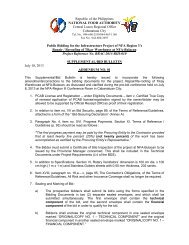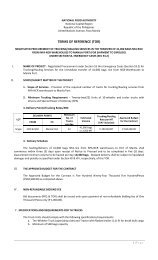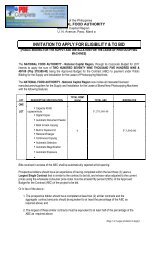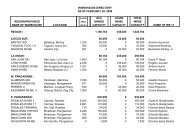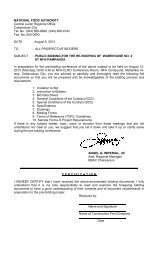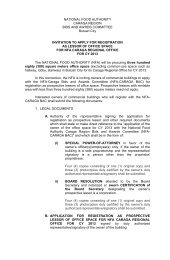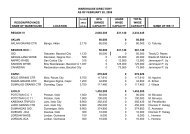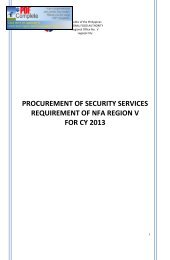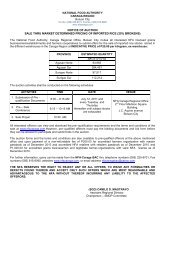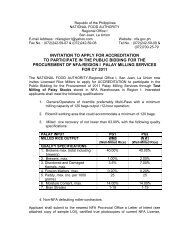Word Pro - Validation of Weight Loss Measurements - Nfa.gov.ph
Word Pro - Validation of Weight Loss Measurements - Nfa.gov.ph
Word Pro - Validation of Weight Loss Measurements - Nfa.gov.ph
You also want an ePaper? Increase the reach of your titles
YUMPU automatically turns print PDFs into web optimized ePapers that Google loves.
NATIONAL FOOD AUTHORITY<br />
Quezon City<br />
<strong>Validation</strong> <strong>of</strong> <strong>Weight</strong> <strong>Loss</strong> <strong>Measurements</strong><br />
By<br />
Engr. TESIE Q. RAMIREZ<br />
Statistician III<br />
LITA B. BERNAL<br />
Research Specialist<br />
Engr. MA. ELVIRA M. MARTINEZ<br />
Division Chief III<br />
Technology Resource Development Department<br />
Technical Research Division<br />
May 2002
I. BASIC INFORMATION<br />
Republic <strong>of</strong> the Philippines<br />
NATIONAL FOOD AUTHORITY<br />
Quezon City<br />
1. Research Title : <strong>Validation</strong> <strong>of</strong> <strong>Weight</strong> <strong>Loss</strong><br />
<strong>Measurements</strong><br />
2. Researchers : Engr. Tessie Q. Ramirez<br />
Lita B. Bernal<br />
3. Implementing Agency : National Food Authority<br />
4. Research Sites : NFA-Cabanatuan City<br />
5. Funding Agency : National Food Authority<br />
6. Duration : 48 months<br />
7. Development Zone : Storage <strong>Loss</strong> <strong>Pro</strong>cedures<br />
8. Commodity : Palay
ABSTRACT<br />
<strong>Validation</strong> <strong>of</strong> <strong>Weight</strong> <strong>Loss</strong> <strong>Measurements</strong> 1<br />
By<br />
Tessie Q. Ramirez and Lita B. Bernal 2<br />
The weight-volume method and the thousand grain mass (TGM) are two procedures for<br />
weight loss determination for paddy. These were tested and compared with the results <strong>of</strong><br />
the total weight loss assessment procedure.<br />
The weight loss derived from the weight-volume method showed significant relationship<br />
with storage period. But when compared with the weight loss results <strong>of</strong> the total weight<br />
loss assessment procedure, the weight-volume method results came out to be significantly<br />
different.<br />
The weight-volume method could be a good tool in measuring or predicting the estimated<br />
loss <strong>of</strong> stored palay. This method includes losses brought about by all possible<br />
nature-caused factors. Refinement <strong>of</strong> the procedure is therefore necessary for it to<br />
become acceptable.<br />
On the other hand, the weight loss generated from the thousand grain mass procedure<br />
yielded insignificant relationship with storage period. Thus, it was no longer compared<br />
with the results <strong>of</strong> the total weight loss assessment. The TGM, therefore, cannot be used<br />
for weight loss determination <strong>of</strong> paddy.<br />
1 Study conducted by the Technical Research Division, Technology Resource Development Department,<br />
National Food Authority, Quezon City.<br />
2<br />
Research Specialists
INTRODUCTION<br />
The perennial problem <strong>of</strong> the National Food Authority is weight loss <strong>of</strong> cereal stocks in<br />
its warehouses. <strong>Loss</strong> assessment had been done to determine weight losses <strong>of</strong> stored<br />
paddy grains. The procedure <strong>of</strong> weight loss assessment involved weighing <strong>of</strong> stocks<br />
which incurred huge expenditures. Warehouse transaction receipts and issues <strong>of</strong> stocks<br />
could not be used to come up <strong>of</strong> specific data loss since the stocks and recording were not<br />
under the control and monitoring <strong>of</strong> researchers.<br />
Adams and Schulten (1976) presented simpler ways <strong>of</strong> determining storage loss through<br />
Standard Volume/<strong>Weight</strong> Method. The procedure primarily involves moisture and<br />
weight determination <strong>of</strong> grains at a given standard volume. Above all, the procedure is<br />
inexpensive.<br />
Likewise, <strong>Pro</strong>ctor and Rowley (1983) devised the Thousand Grain Mass (TGM) in<br />
determining weight loss <strong>of</strong> grains. The procedure is also simple and inexpensive. It also<br />
involves moisture and weight determination and counting <strong>of</strong> weighed grains.<br />
Both procedures do not involve large amount <strong>of</strong> money and can be both adopted as part <strong>of</strong><br />
warehouse operations to predict weight losses in case these procedures are found<br />
effective.<br />
REVIEW OF LITERATURE<br />
The rice weevil consumes rice when living in the kernel. If the kernel is weighed before<br />
and after it is bored, it will have lost weight. The rat and birds also consume part <strong>of</strong> the<br />
stored grain. If the stocks are weighed before and after storage, losses will be recorded.<br />
This lost in weight is the removed food grain from the direct human food chain which is<br />
the basic source <strong>of</strong> energy <strong>of</strong> most people in developing countries.<br />
On the other hand, loss <strong>of</strong> weight due to moisture may not be a loss <strong>of</strong> food grain.<br />
However, in the accounting system <strong>of</strong> the NFA, it is considered a weight loss which<br />
equivalent cost must be determined. Likewise, pilferage must not be considered a loss. It<br />
is a transfer <strong>of</strong> ownership, and is punishable.<br />
<strong>Loss</strong>es in storage are caused by the activities <strong>of</strong> various macro- and microorganisms<br />
made possible by man’s failure to understand and follow proper storage principles and<br />
practices. <strong>Loss</strong>es caused by mite and insect infestation and by the depredations <strong>of</strong> large<br />
animals such as rats, mice and birds are obvious. Thus, the means <strong>of</strong> control <strong>of</strong> these pests<br />
are generally known and supposed to be practiced. <strong>Loss</strong>es caused by the activities <strong>of</strong><br />
microorganisms are less understood and <strong>of</strong>ten unrecognized.<br />
This study, however, does not focus on the factors <strong>of</strong> losses. It merely attempts to measure<br />
the total loss <strong>of</strong> stored grains.
OBJECTIVE<br />
The study aimed to validate the Standard Volume/<strong>Weight</strong> method designed by Adams and<br />
Schulten (1976) and the Thousand Grain Mass method designed by <strong>Pro</strong>ctor and Rowley<br />
(1983) in determining weight loss <strong>of</strong> cereals with an end view <strong>of</strong> arriving at a simpler and<br />
acceptable procedure <strong>of</strong> predicting weight loss for adoption into the NFA operations.<br />
METHODOLOGY<br />
Three piles <strong>of</strong> paddy containing about 5,000 bags per pile were used for this study. These<br />
were stored at warehouse 7 at the NFA Complex in Cabanatuan City. Three loss<br />
measurement methods were used: the weight-volume method, the thousand grain mass,<br />
and the total weight loss assessment.<br />
A. Assessment <strong>of</strong> <strong>Loss</strong> Measurement Methods<br />
1. Standard <strong>Weight</strong>/Volume Method<br />
1.1 Baseline Determination<br />
A baseline was necessary to be established as basis for succeeding<br />
measurements since the weight-to-volume method was based on varying weights<br />
for different levels <strong>of</strong> loss. The baseline was in the form <strong>of</strong> curve covering<br />
several moisture conditions possible for paddy. Paddy volume changed at<br />
varying moisture contents. The baseline curve was inevitable because it served<br />
as reference point in comparing losses incurred during storage.<br />
About ten kilograms <strong>of</strong> paddy were obtained from the three experimental piles.<br />
These were thoroughly mixed until sub-samples for moisture content<br />
determination were obtained. The paddy moisture was recorded at 13.2%<br />
Using the weight per liter tester, the weight <strong>of</strong> a standard volume (1000 cc) <strong>of</strong><br />
the well-mixed 10-kg paddy sample was immediately obtained and recorded.<br />
After taking the weight <strong>of</strong> the one-liter liter palay, this was sun-dried, tempered,<br />
and the moisture content and weight per liter were again determined. Sun drying<br />
<strong>of</strong> the palay was again immediately done to obtain a lower MC. The drying,<br />
moisture determination, and weight per liter monitoring were continuously done<br />
until the paddy was dried to almost 8% moisture. Sund rying was done up to a<br />
moisture level <strong>of</strong> about 9%. Drying up <strong>of</strong> the paddy to less than 9% was<br />
unsuccessful, thus the air oven was used to dry the grains dopwn to about 8%<br />
moisture.<br />
The palay moisture and its corresponding weight per 1000 cc were plotted to<br />
come up with a baseline which was used as reference in loss measurement. The
weights in the baseline were referred to as Wi while the moisture contents were<br />
referred to as MCi.<br />
1.2 <strong>Loss</strong> Measurement<br />
For the first three months, samples were withdrawn weekly and separately from<br />
each pile. Analysis <strong>of</strong> the samples were on per pile basis. A well-mixed sample<br />
was analyzed <strong>of</strong> its moisture content and weight using the weight per liter tester.<br />
The weight was termed Wf. while the moisture was MCf.<br />
Using the baseline figure, a vertical line was drawn from the moisture content<br />
axis (X axis) equivalent to the MCf. Where the MCf vertical line intersected on<br />
the baseline, a horizontal line was drawn going to the weight per liter axis<br />
(Y-axis). The datum obtained was Wf. This procedure was subsequently used<br />
every monitoring time to determine the estimated change in weight <strong>of</strong> the stored<br />
palay. The percentage weight loss was calculated using the formula:<br />
% <strong>Weight</strong> <strong>Loss</strong> (Wt.-Vol.) = Wi - Wf x 100<br />
Where % <strong>Weight</strong> <strong>Loss</strong> (Wt-Vol) is the cumulative weight loss using the<br />
weight-volume method<br />
Wi is the weight found on the baseline<br />
2. Thousand Grain Mass<br />
Wi<br />
Wf is the weight at a given monitoring time<br />
Using the same paddy samples utilized in the moisture content and volume-weight<br />
determination, grains were counted up to 1000 for several trials at the start <strong>of</strong> the<br />
experiment. Counting was also on per pile basis. The counted paddy grains were<br />
weighed and recorded as Thousand Grain Mass (TGM).<br />
Subsequent readings <strong>of</strong> TGM were done along with the volume-weight<br />
determination.<br />
The weight loss was determined using the following formula:<br />
% <strong>Weight</strong> <strong>Loss</strong> (TGM) = Wi - Wf x 100<br />
Wi<br />
where Wi = initial weight <strong>of</strong> 1000 grains (taken at the start <strong>of</strong> the experiment)<br />
Wf = weight at a given time
3. Total <strong>Weight</strong> <strong>Loss</strong> Assessment<br />
The weights <strong>of</strong> the three experimental piles were recorded at the start <strong>of</strong> piling.<br />
Subsequent re-weighing every three months was done to determine the actual weight<br />
loss incurred by the palay while in storage. This procedure was considered as<br />
control among all the methods presented.<br />
The total weight loss was calculated as follows:<br />
period.<br />
% Total <strong>Weight</strong> <strong>Loss</strong> = Wi - Wf x 100<br />
Wi<br />
Where % Total <strong>Weight</strong> <strong>Loss</strong> = cumulative weight loss obtained by quarterly<br />
weighing <strong>of</strong> the palay stocks<br />
Wi = initial weight <strong>of</strong> the experimental palay stocks<br />
Wf = weight <strong>of</strong> the experimental palay stocks at a given monitoring<br />
The weight loss results from the volume-weight method, thousand grain mass, and Total<br />
<strong>Weight</strong> <strong>Loss</strong> assessment were compared.<br />
DISCUSSION OF RESULTS<br />
1. Volume-<strong>Weight</strong> Method<br />
1.1 Baseline<br />
Figure 1 shows the baseline which represents the true condition <strong>of</strong> the paddy<br />
without any weight loss except moisture. This line is being used as reference in<br />
determining weight loss <strong>of</strong> stored paddy. The baseline shows a linear downward<br />
trend as moisture increases. This trend indicates that the weight <strong>of</strong> palay at<br />
constant volume is heavier when dried. This result agrees with the trend <strong>of</strong> the<br />
sample baseline figure <strong>of</strong> unidentified cereal given by Adams and Schulten<br />
(1976).<br />
At a fixed volume, the drier paddy grains are more heavy compared to the grains<br />
with higher moisture content. This means that more grains are contained in the<br />
fixed volume container when they are drier. Or in a smaller scale, a single dry<br />
grain occupies lesser volume than a wet grain.<br />
The derived baseline appears to be a good reference because the data points are<br />
not scattered over a wide area.
1.2 <strong>Loss</strong> Measurement<br />
The average moisture content behavior <strong>of</strong> the paddy is given in Figure 2. It<br />
shows a downward logarithmic trend <strong>of</strong> moisture content indicating that the<br />
grains dry up during storage. Although moisture loss is not a food loss, still, it is<br />
considered a quantitative loss in NFA operation which, if not properly<br />
accounted, may become a problem on the part <strong>of</strong> the accountable <strong>of</strong>ficer.<br />
Likewise, the weight <strong>of</strong> the paddy grains decreases at prolonged storage as<br />
shown in Figure 3. One <strong>of</strong> the factors <strong>of</strong> weight loss is moisture loss. Other<br />
cause <strong>of</strong> weight loss is the loss <strong>of</strong> a portion <strong>of</strong> the grain which may be due to<br />
insect or rodent consumption and grain respiration (Houston, 1972).<br />
The weight <strong>of</strong> the paddy contained in a fixed volume container is inversely<br />
proportional with time or storage period. Conversely, the equivalent weight lost<br />
is directly proportional with storage period as shown in Figure 5. The trend <strong>of</strong><br />
weight <strong>of</strong> paddy lost as measured through the weight-volume method is<br />
logarithmic. The positive slope (the coefficient <strong>of</strong> the variable X which is +1.19<br />
as shown in Table 1) also proves that the weight loss is directly proportional<br />
with storage period.<br />
The regression equation is considered accurate based from its correlation<br />
coefficient, r 2 , <strong>of</strong> 0.896. At 95% confidence level, the weight loss from the<br />
weight-volume method was found out to have a significant relationship with<br />
time having a probability, P, <strong>of</strong> less than 0.05% (Table 1).<br />
2. Thousand Grain Mass<br />
Figure 4 shows the scatter plot <strong>of</strong> TGM <strong>of</strong> paddy while in storage. The scatter plot<br />
is widely spread, indicating no trend for TGM curve. The scatter plot apparently<br />
indicates that the grains constantly gain and lose weight. The grains may<br />
occasionally gain weight due to moisture absorption when the humidity becomes<br />
high but, most <strong>of</strong> the time, it frequently loses some <strong>of</strong> its weight until it is in<br />
equilibrium to its relatively low-humidity environment. But using the TGM, it<br />
appears that the grains constantly gain and lose weight which is not expected to<br />
happen. There are definitely other contributory factors, aside from moisture<br />
absorption/desorption, why the constant gain and loss behavior happens as the TGM<br />
scatter plot suggests. One major factor is the naturally occurring variability in<br />
individual grain weights. This factor <strong>of</strong> error can hardly be minimized because <strong>of</strong><br />
the very small quantity <strong>of</strong> samples analyzed, being only 1000 grains per trial.<br />
Another on going TRDD research project, “Performance Evaluation <strong>of</strong> Bulk Storage<br />
Facilities in Isabela,” conducted by Sugue et al. showed similar erratic pattern <strong>of</strong><br />
TGM behavior in its initial results.<br />
Still the weight loss <strong>of</strong> paddy measured through TGM, was tested to confirm the<br />
result <strong>of</strong> the scatter plot. The weight loss pattern is shown in Figure 5. However, the
2 is very low, meaning the derived relationship is not a good predictor for weight
loss. The probability P is also higher than 0.05% confidence level (Table 1), hence<br />
the weight loss has no relationship with storage period. TGM is, therefore, not a<br />
good tool to measure the weight loss <strong>of</strong> paddy.<br />
3. Total <strong>Weight</strong> <strong>Loss</strong> Assessment<br />
The actual total weight loss <strong>of</strong> the paddy grains taken from weighing <strong>of</strong> the whole<br />
three piles is also shown in Figure 5. The gra<strong>ph</strong> shows that there is a direct<br />
relationship with time. Its trend is also logarithmic with r 2 <strong>of</strong> 0.944. The probability<br />
P is also much lower than 0.05% (Table 1), hence weight loss has significant<br />
relationship with storage period. The equation <strong>of</strong> the line is also shown in Table 1.<br />
B. Comparison <strong>of</strong> <strong>Weight</strong> <strong>Loss</strong> Measurement Methods<br />
Referring to Figure 5, the weight loss results from the volume-weight method has<br />
similar logarithmic pattern with total weight loss assessment results. However, their<br />
scatter plots in Figure 5 further show that the weight loss derived from the<br />
weight-volume method is quite higher than those derived from the total weight loss<br />
assessment.<br />
The weight loss data were then subjected to further test to compare both weight loss<br />
measurement procedures. Table 2 shows the comparison <strong>of</strong> results: that total weight<br />
loss method is significantly different from weight-volume method.<br />
If the scatter plots are to be scrutinized again, it can be observed that the<br />
considerable increase in weight loss <strong>of</strong> palay using the weight volume method, as<br />
compared to the total weight loss assessment, started almost after about 60 days. It is<br />
reasonably probable that the contributory factor to the sudden increase in weight<br />
loss as measured by the weight-volume method are the mothballs or lumps <strong>of</strong> grain<br />
webbed together by insects.<br />
Mothballs usually form in stored palay after sometime in storage, when pests and/or<br />
insects thrive and proliferate in the stocks. The mothballs are not closely knitted<br />
well thereby forming loose lumps. If the mothballs become part <strong>of</strong> the one-liter<br />
sample for weight per liter testing, then the resulting weight may be low because the<br />
mothballs that are loosely knitted occupy a larger space in the one-liter volume.<br />
The TGM is no longer compared with the two methods because it has already been<br />
found out to have no significant relationship with time.
CONCLUSION AND RECOMMENDATION<br />
There still has no loss measurement method that can surpass the total weight loss<br />
assessment method. The weight-volume method and the thousand grain mass may need<br />
some more refinement in order to come up with loss assessment which can be adopted for<br />
storage operations.<br />
The weight-volume method could have been a good procedure in determining the weight<br />
loss <strong>of</strong> stored paddy because all natural or biological losses (caused by respiration) and<br />
insect and pest consumption can be recorded with this procedure. Unfortunately, the<br />
method has shown larger amount <strong>of</strong> loss compared to total weight loss assessment.<br />
Mothballs or lumps <strong>of</strong> loosely webbed grains occupying larger than the usual space in the<br />
container may have caused the discrepancy. Thus, further refinement <strong>of</strong> the procedure<br />
may be needed.<br />
In refining the weight-volume method, the primary consideration now is to remove<br />
mothballs before testing the palay samples. It is tempting to recommend that the samples<br />
be cleaned prior to testing. However, there is a point <strong>of</strong> contention in the cleaning <strong>of</strong><br />
samples prior to testing as far as NFA operations are concerned. If cleaned, then the<br />
sample would not become a representative to the whole stock. Thus, all angles <strong>of</strong> possible<br />
sources <strong>of</strong> error must be determined and studied. When perfected, the weight loss, caused<br />
by unavoidable reasons, <strong>of</strong> a given stock <strong>of</strong> paddy can be predicted. If perfected, it is also<br />
highly probable that the weight-volume method may be comparable to the total weight<br />
loss assessment method. The scatter plots <strong>of</strong> both methods so indicate.<br />
REFERENCES<br />
Harris, K. L. and Carl J. Lindbland. 1978. Postharvest Grain <strong>Loss</strong> Assessment Methods.<br />
AACC.<br />
Houston, D. F. 1972. RICE: Chemistry and Technology. AACC. St. Paul, Minnesota<br />
<strong>Pro</strong>ctor, D. L. and J. O. Rowley. ND. The Thousand Grain Mass (TGM) A Basis for<br />
Better Assessment <strong>of</strong> <strong>Weight</strong> <strong>Loss</strong>es in Stored Grain. Unpublished report.<br />
tess/pc2/loss measurement-pr2.lwp
<strong>Weight</strong>, g per 1000 cc<br />
505<br />
500<br />
495<br />
490<br />
485<br />
480<br />
475<br />
470<br />
465<br />
Figure 1. Baseline<br />
7 8 9 10 11 12 13 14<br />
Moisture Content, %
% Moisture Content<br />
14<br />
13.5<br />
13<br />
12.5<br />
12<br />
11.5<br />
11<br />
Figure 2. % Moisture Content <strong>of</strong> Stored Paddy<br />
R-square = 0.934 # pts = 44<br />
y = 14.4 - 0.426(lnx)<br />
0 100 200 300 400 500 600 700 800 900<br />
Storage Period, days
<strong>Weight</strong>, g, per 1000 cc<br />
500<br />
490<br />
480<br />
470<br />
460<br />
450<br />
Figure 3. <strong>Weight</strong> Changes <strong>of</strong> Stored Paddy<br />
0 100 200 300 400 500 600 700 800 900<br />
Storage Period, days<br />
R-square = 0.807 # pts = 45<br />
y = 483 + -3.37(lnx)
Thousand Grain Mass, g<br />
24.5<br />
24<br />
23.5<br />
23<br />
22.5<br />
22<br />
Figure 4. Thousand Grain Mass <strong>of</strong> Stored Paddy<br />
0 100 200 300 400 500 600 700 800 900<br />
Storage Period, days
% Total <strong>Weight</strong> <strong>Loss</strong><br />
Figure 5. Comparison <strong>of</strong> <strong>Weight</strong> <strong>Loss</strong> <strong>Measurements</strong><br />
5<br />
4<br />
3<br />
2<br />
1<br />
0<br />
-1<br />
Wt-Vol<br />
TWL control<br />
0 100 200 300 400 500 600 700 800 900<br />
Storage Period, days




